Asim Smailagic
Design, Development, and Evaluation of an Interactive Personalized Social Robot to Monitor and Coach Post-Stroke Rehabilitation Exercises
May 12, 2023Abstract:Socially assistive robots are increasingly being explored to improve the engagement of older adults and people with disability in health and well-being-related exercises. However, even if people have various physical conditions, most prior work on social robot exercise coaching systems has utilized generic, predefined feedback. The deployment of these systems still remains a challenge. In this paper, we present our work of iteratively engaging therapists and post-stroke survivors to design, develop, and evaluate a social robot exercise coaching system for personalized rehabilitation. Through interviews with therapists, we designed how this system interacts with the user and then developed an interactive social robot exercise coaching system. This system integrates a neural network model with a rule-based model to automatically monitor and assess patients' rehabilitation exercises and can be tuned with individual patient's data to generate real-time, personalized corrective feedback for improvement. With the dataset of rehabilitation exercises from 15 post-stroke survivors, we demonstrated our system significantly improves its performance to assess patients' exercises while tuning with held-out patient's data. In addition, our real-world evaluation study showed that our system can adapt to new participants and achieved 0.81 average performance to assess their exercises, which is comparable to the experts' agreement level. We further discuss the potential benefits and limitations of our system in practice.
ExplainFix: Explainable Spatially Fixed Deep Networks
Mar 18, 2023Abstract:Is there an initialization for deep networks that requires no learning? ExplainFix adopts two design principles: the "fixed filters" principle that all spatial filter weights of convolutional neural networks can be fixed at initialization and never learned, and the "nimbleness" principle that only few network parameters suffice. We contribute (a) visual model-based explanations, (b) speed and accuracy gains, and (c) novel tools for deep convolutional neural networks. ExplainFix gives key insights that spatially fixed networks should have a steered initialization, that spatial convolution layers tend to prioritize low frequencies, and that most network parameters are not necessary in spatially fixed models. ExplainFix models have up to 100x fewer spatial filter kernels than fully learned models and matching or improved accuracy. Our extensive empirical analysis confirms that ExplainFix guarantees nimbler models (train up to 17\% faster with channel pruning), matching or improved predictive performance (spanning 13 distinct baseline models, four architectures and two medical image datasets), improved robustness to larger learning rate, and robustness to varying model size. We are first to demonstrate that all spatial filters in state-of-the-art convolutional deep networks can be fixed at initialization, not learned.
HeartSpot: Privatized and Explainable Data Compression for Cardiomegaly Detection
Oct 05, 2022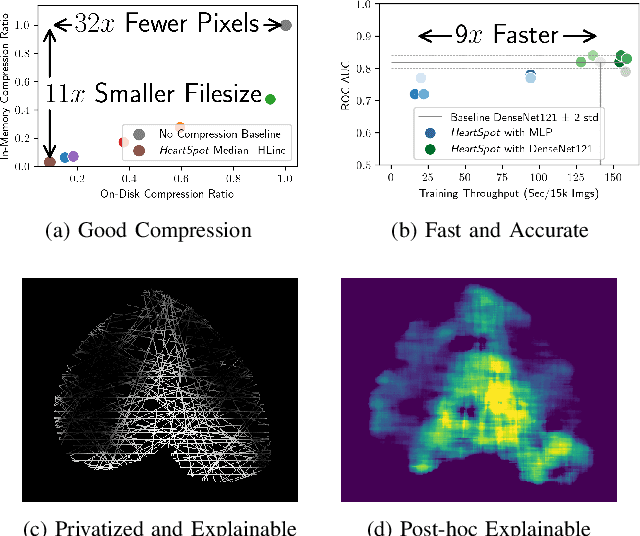
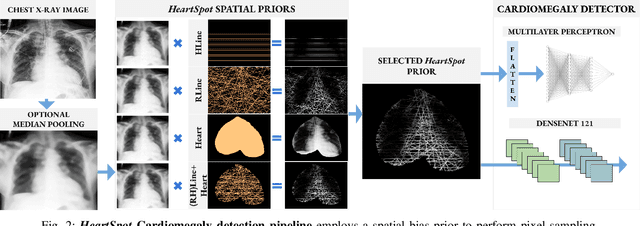


Abstract:Advances in data-driven deep learning for chest X-ray image analysis underscore the need for explainability, privacy, large datasets and significant computational resources. We frame privacy and explainability as a lossy single-image compression problem to reduce both computational and data requirements without training. For Cardiomegaly detection in chest X-ray images, we propose HeartSpot and four spatial bias priors. HeartSpot priors define how to sample pixels based on domain knowledge from medical literature and from machines. HeartSpot privatizes chest X-ray images by discarding up to 97% of pixels, such as those that reveal the shape of the thoracic cage, bones, small lesions and other sensitive features. HeartSpot priors are ante-hoc explainable and give a human-interpretable image of the preserved spatial features that clearly outlines the heart. HeartSpot offers strong compression, with up to 32x fewer pixels and 11x smaller filesize. Cardiomegaly detectors using HeartSpot are up to 9x faster to train or at least as accurate (up to +.01 AUC ROC) when compared to a baseline DenseNet121. HeartSpot is post-hoc explainable by re-using existing attribution methods without requiring access to the original non-privatized image. In summary, HeartSpot improves speed and accuracy, reduces image size, improves privacy and ensures explainability. Source code: https://www.github.com/adgaudio/HeartSpot
Enabling AI and Robotic Coaches for Physical Rehabilitation Therapy: Iterative Design and Evaluation with Therapists and Post-Stroke Survivors
Jun 15, 2021
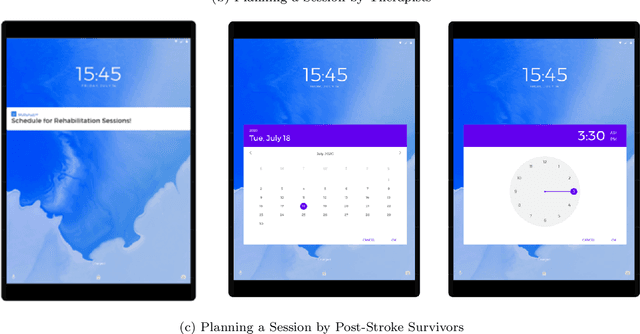
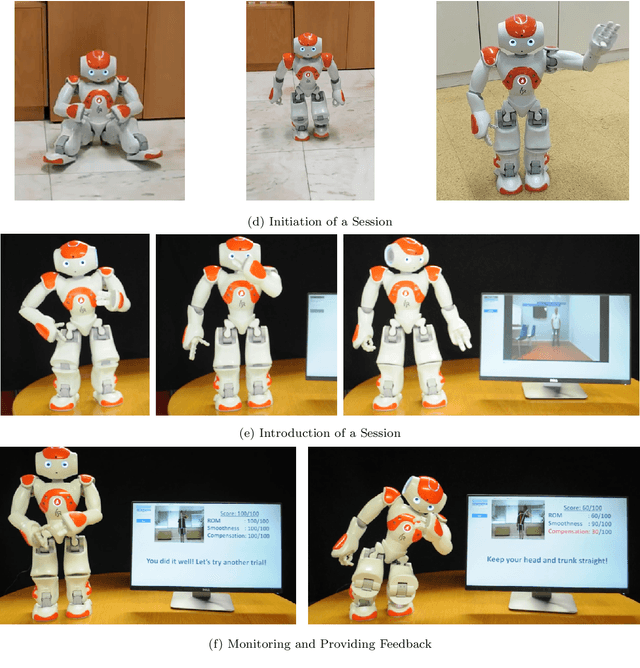
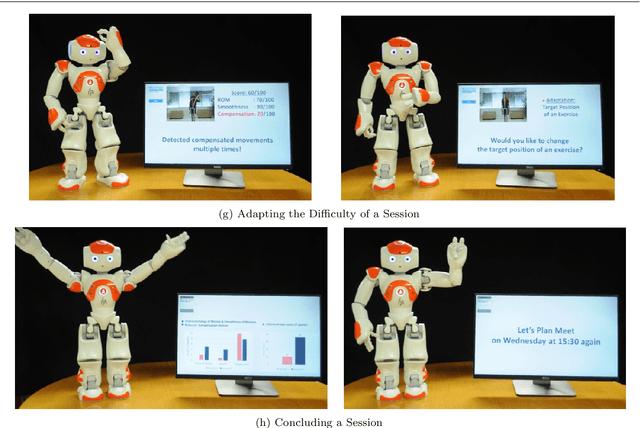
Abstract:Artificial intelligence (AI) and robotic coaches promise the improved engagement of patients on rehabilitation exercises through social interaction. While previous work explored the potential of automatically monitoring exercises for AI and robotic coaches, the deployment of these systems remains a challenge. Previous work described the lack of involving stakeholders to design such functionalities as one of the major causes. In this paper, we present our efforts on eliciting the detailed design specifications on how AI and robotic coaches could interact with and guide patient's exercises in an effective and acceptable way with four therapists and five post-stroke survivors. Through iterative questionnaires and interviews, we found that both post-stroke survivors and therapists appreciated the potential benefits of AI and robotic coaches to achieve more systematic management and improve their self-efficacy and motivation on rehabilitation therapy. In addition, our evaluation sheds light on several practical concerns (e.g. a possible difficulty with the interaction for people with cognitive impairment, system failures, etc.). We discuss the value of early involvement of stakeholders and interactive techniques that complement system failures, but also support a personalized therapy session for the better deployment of AI and robotic exercise coaches.
Enhancement of Retinal Fundus Images via Pixel Color Amplification
Jul 28, 2020

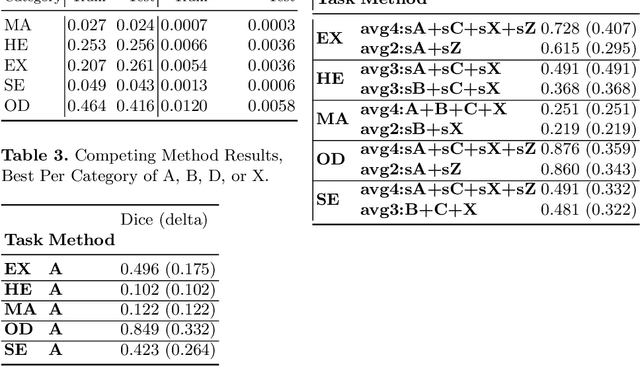
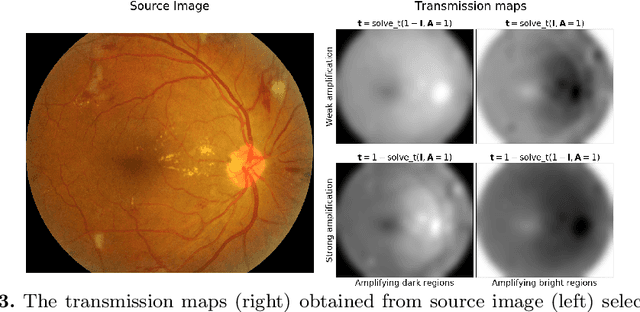
Abstract:We propose a pixel color amplification theory and family of enhancement methods to facilitate segmentation tasks on retinal images. Our novel re-interpretation of the image distortion model underlying dehazing theory shows how three existing priors commonly used by the dehazing community and a novel fourth prior are related. We utilize the theory to develop a family of enhancement methods for retinal images, including novel methods for whole image brightening and darkening. We show a novel derivation of the Unsharp Masking algorithm. We evaluate the enhancement methods as a pre-processing step to a challenging multi-task segmentation problem and show large increases in performance on all tasks, with Dice score increases over a no-enhancement baseline by as much as 0.491. We provide evidence that our enhancement preprocessing is useful for unbalanced and difficult data. We show that the enhancements can perform class balancing by composing them together.
Improving Lesion Segmentation for Diabetic Retinopathy using Adversarial Learning
Jul 27, 2020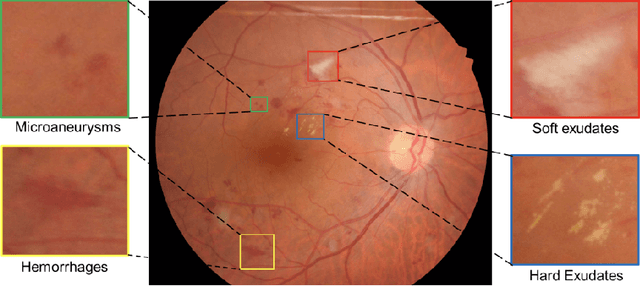

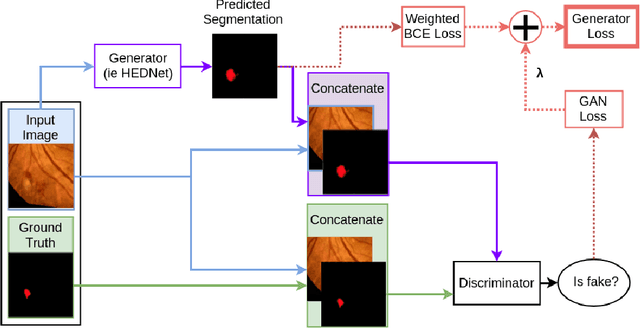

Abstract:Diabetic Retinopathy (DR) is a leading cause of blindness in working age adults. DR lesions can be challenging to identify in fundus images, and automatic DR detection systems can offer strong clinical value. Of the publicly available labeled datasets for DR, the Indian Diabetic Retinopathy Image Dataset (IDRiD) presents retinal fundus images with pixel-level annotations of four distinct lesions: microaneurysms, hemorrhages, soft exudates and hard exudates. We utilize the HEDNet edge detector to solve a semantic segmentation task on this dataset, and then propose an end-to-end system for pixel-level segmentation of DR lesions by incorporating HEDNet into a Conditional Generative Adversarial Network (cGAN). We design a loss function that adds adversarial loss to segmentation loss. Our experiments show that the addition of the adversarial loss improves the lesion segmentation performance over the baseline.
Learned Pre-Processing for Automatic Diabetic Retinopathy Detection on Eye Fundus Images
Jul 27, 2020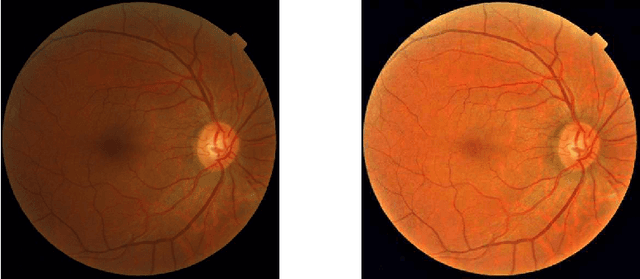
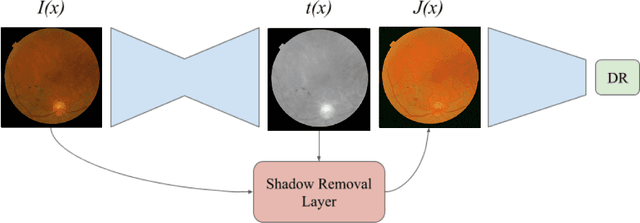
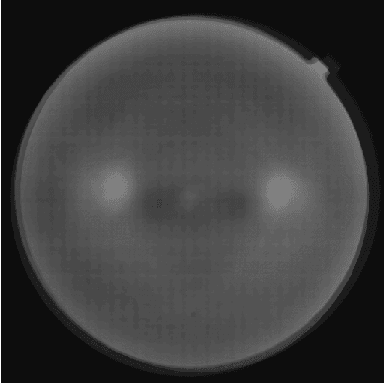
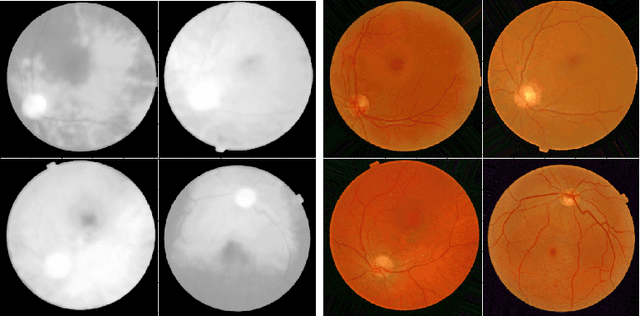
Abstract:Diabetic Retinopathy is the leading cause of blindness in the working-age population of the world. The main aim of this paper is to improve the accuracy of Diabetic Retinopathy detection by implementing a shadow removal and color correction step as a preprocessing stage from eye fundus images. For this, we rely on recent findings indicating that application of image dehazing on the inverted intensity domain amounts to illumination compensation. Inspired by this work, we propose a Shadow Removal Layer that allows us to learn the pre-processing function for a particular task. We show that learning the pre-processing function improves the performance of the network on the Diabetic Retinopathy detection task.
Designing Personalized Interaction of a Socially Assistive Robot for Stroke Rehabilitation Therapy
Jul 13, 2020

Abstract:The research of a socially assistive robot has a potential to augment and assist physical therapy sessions for patients with neurological and musculoskeletal problems (e.g. stroke). During a physical therapy session, generating personalized feedback is critical to improve patient's engagement. However, prior work on socially assistive robotics for physical therapy has mainly utilized pre-defined corrective feedback even if patients have various physical and functional abilities. This paper presents an interactive approach of a socially assistive robot that can dynamically select kinematic features of assessment on individual patient's exercises to predict the quality of motion and provide patient-specific corrective feedback for personalized interaction of a robot exercise coach.
Opportunities of a Machine Learning-based Decision Support System for Stroke Rehabilitation Assessment
Mar 02, 2020
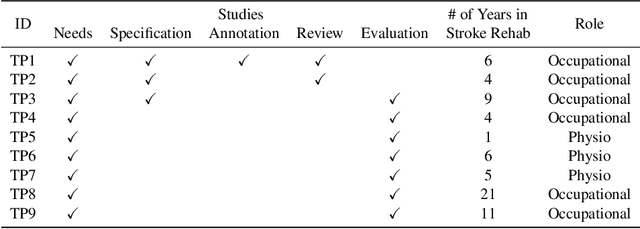
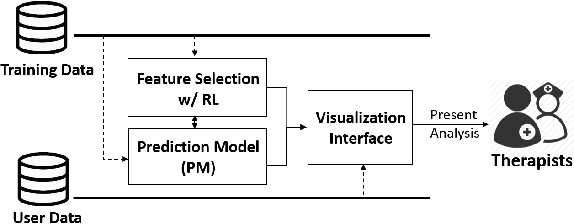

Abstract:Rehabilitation assessment is critical to determine an adequate intervention for a patient. However, the current practices of assessment mainly rely on therapist's experience, and assessment is infrequently executed due to the limited availability of a therapist. In this paper, we identified the needs of therapists to assess patient's functional abilities (e.g. alternative perspective on assessment with quantitative information on patient's exercise motions). As a result, we developed an intelligent decision support system that can identify salient features of assessment using reinforcement learning to assess the quality of motion and summarize patient specific analysis. We evaluated this system with seven therapists using the dataset from 15 patient performing three exercises. The evaluation demonstrates that our system is preferred over a traditional system without analysis while presenting more useful information and significantly increasing the agreement over therapists' evaluation from 0.6600 to 0.7108 F1-scores ($p <0.05$). We discuss the importance of presenting contextually relevant and salient information and adaptation to develop a human and machine collaborative decision making system.
O-MedAL: Online Active Deep Learning for Medical Image Analysis
Aug 28, 2019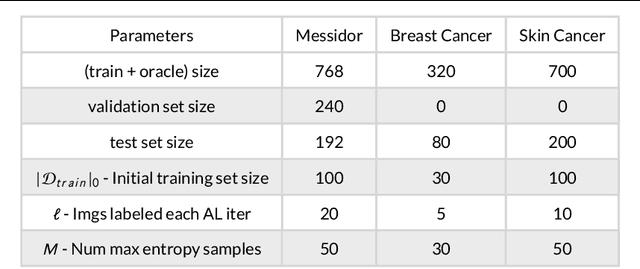
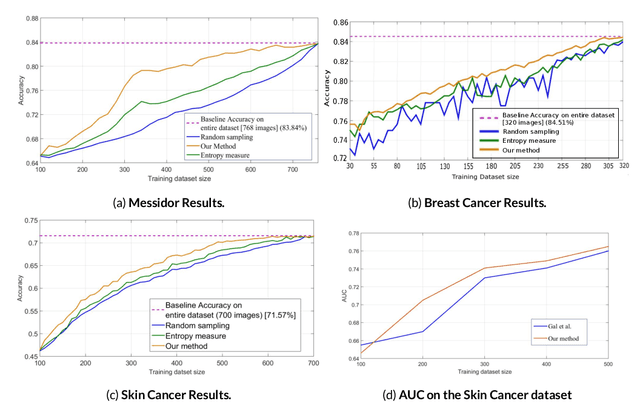

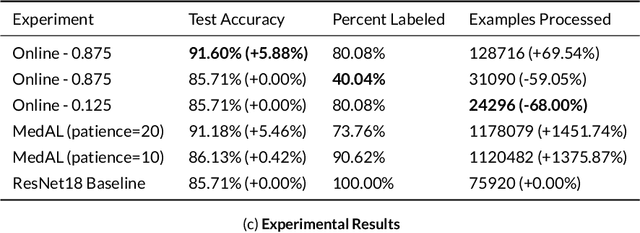
Abstract:Active Learning methods create an optimized and labeled training set from unlabeled data. We introduce a novel Online Active Deep Learning method for Medical Image Analysis. We extend our MedAL active learning framework to present new results in this paper. Experiments on three medical image datasets show that our novel online active learning model requires significantly less labelings, is more accurate, and is more robust to class imbalances than existing methods. Our method is also more accurate and computationally efficient than the baseline model. Compared to random sampling and uncertainty sampling, the method uses 275 and 200 (out of 768) fewer labeled examples, respectively. For Diabetic Retinopathy detection, our method attains a 5.88% accuracy improvement over the baseline model when 80% of the dataset is labeled, and the model reaches baseline accuracy when only 40% is labeled.
 Add to Chrome
Add to Chrome Add to Firefox
Add to Firefox Add to Edge
Add to Edge